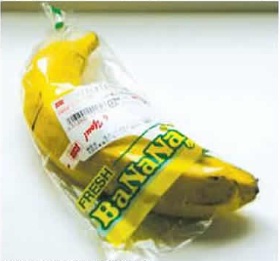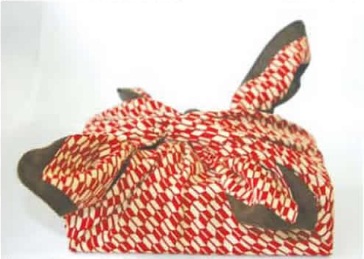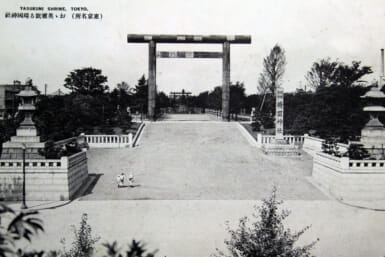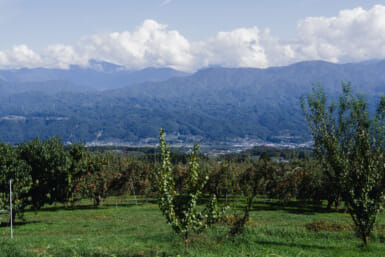Danielle Tate-Stratton unwraps ways to reduce your waste in Japan
Across the developed world, we collectively use much more than our allotted share of the earth’s resources. As it stands now, the average citizen of Japan uses 4.8 global hectares (a hectare of land which is able to aid in the sustenance of life), and the average American uses around nine! Worryingly, scientists estimate there are only around 1.8 productive hectares per person on the planet. See how you compare to others in Japan or in your home country at www.earthday.org/footprint-calculator.
While there are certain things that all developed countries do to contribute to this increasing problem, such as over using water and electricity, eating imported, processed, and packaged foods, and generally living in ‘throw-away’ societies, there seem to be some culturally-specific ways in which one country contributes more towards global warming than the others. For instance, North Americans are infamous for their gas-guzzling SUVs and long-distance driving, New Zealanders, with their 20 or so sheep per person, are pumping out methane, said to be 21 times more damaging to the earth than the much discussed carbon dioxide, at an alarming rate, and here in Japan, it seems safe to say that our personal over-consumption revolves around packaging.
We’ve all been to a shop to buy a pen, only to have it popped into a paper sleeve, taped down, put into a larger bag, taped down, and then handed over; with a plastic covering over the paper bag if there is even so much as a hint of rain in the air. Most convenience stores don’t ask if you want a bag, and they are so efficient that your beverage, which you plan to drink immediately, can be wrapped up nicely in a plastic bag before you’ve even finished counting out your change to pay.
Statistically, packaging is big business in Japan. According to the Japan Packaging Institute (www.jpi.or.jp/english/index.htm), the shipment value of packaging materials and containers in 2006 was ¥5,964,300,000,000(that’s5,964.3 billion yen!), a slight increase over 2005. The packaging industry, whose total value reached ¥6,249.7 billion in 2006, accounted for a full 1.29 percent of Japan’s overall gross domestic product (GDP). Besides being somewhat overkill (do carrots and bananas really need to be individually wrapped?), the 20.78 million tons of packaging consumed in Japan each year (the UK produces five million tons) do little to help keep landfills empty, and in a country where gomi is burned, space may not be such a problem, but chemical emissions certainly are! Burning plastics emit toxins, furans (en.wikipedia.org/wiki/Furan), and dioxins (en.wikipedia.org/wiki/Dioxins), which besides being bad for the environment—according to the BBC, burning plastic is equivalent to burning a fossil fuel as it is made from oil, is also bad for us. In fact, the Dean of the Faculty of Mechanical and Chemical Engineering at Dar Es Salaam University, Professor Jamidu Katima, stated that beyond causing asthma, cancer, impotence, and allergies, burning plastic, said to be toxic because it contains chlorine, can also cause changes in gender-related behavior—it has been shown to cause male birds to act like females and vice versa, an effect that Professor Katima maintains could also affect humans.
Paper bags require more energy not only
to create but also to recycle than plastic.
In the late nineties, news of the health risks of dioxin, which include skin disease, musde dysfunction, nervous system disorders and birth defects, reached Japan, especially as elevated levels of the chemicals were found far from Tokyo and Osaka. A 1998 newspaper article from the Los Angeles Times describes how levels of dioxins, which cause breeding problems and deformities in fish and other animals, are at much higher levels in Japan than elsewhere in the world; a direct by-product of Japan’s decision to bum 74 percent of its garbage. While we are required to separate our plastics out, many plastic items get dropped into the burnable bin by accident, and some people and even companies (a few American fast food restaurants come to mind) don’t bother separating their garbage at all. Because a large proportion of the garbage is burnt at municipal incinerators, which aren’t capable of burning out the dioxins, air pollution grows.
Plastics, of which we in Japan discard over 150 pounds of per person per year, also harm wildlife in a more direct way—bags can strangle animals and sea life, a large part of Japan’s ecosytem, is harmed through strangulation or ingestion, which blocks intestines and kills sea turtles, dolphins, and even whales.
Of course, it’s not just the plastics to blame—paper also plays a large role in Japan’s packaging problem, and while biodegradable and recydable, it is certainly not without environmental consequence. Paper bags require more energy not only to create but also to recycle than plastic, and also destroy forests, one of our most valuable natural resources. Ironically, we need the forests to act as carbon sinks (natural carbon absorbers) more than ever, but we continually destroy them nonetheless.
Clearly the solution is to, wherever possible, say no to the two layers of wrapping on your pack of combini gum and look to incorporating reusable bags into your shopping. To start off, it is OK to say no to double wrapping! For instance, National Azabu supermarket encourages shoppers to let them know if they want plastic or paper at the outset, and also to mention if you don’t want Japanese-style packaging; bags over individual items, double wrapping, etc. If you don’t need a bag at all, try “fukuro wa irimasen “.
National Azabu also tries to cut down on its internal packaging needs by reusing boxes they get shipments in for their home delivery service (shoppers should let them know that they are OK with this method of delivery as opposed to bags) and also encourages shoppers to give back the ice packs they use for keeping frozen food cold in the vans for reuse; again, this is partially customer-driven.
Another great way to cut down on your grocery store bag consumption is to start using reusable bags. No longer shapeless cotton sacks, eco-friendly bags designed for your daily shopping needs are now reaching new levels of fashion and popularity. A great example of this is are the “I’m Not a Plastic Bag” bags designed by Anya HindMarch. So popular that the have had to cancel their launches in some South-East Asian cities including Jakarta for “the safety of our customers” the canvas totes, which retail for ¥2,100 here in Japan, inspired 7,000 people to line up when the bags launched here in Tokyo, and in Kyoto, excited shoppers lined up at midnight in anticipation of their chance to own a bag!
Ecobags are also a fantastically stylish way to bring your shopping home. Various designers, including the super-stylish A Bathing Ape, have designed reusable shopping totes, which fit conveniently into a small pouch and are perfect to pop into your purse for unexpected shopping trips. With so many color, style, and material options (some are even made from PET bottles), including special edition totes made by Benetton in Japan (www.benetton.jp), there is sure to be one that takes your fancy. (tinyurl.com/2Ij9kr)
Once you decide to make the jump from plastic to eco, chances are you’ll still have bags of bags stuffed into corners of your home—like single socks, plastic bags have a way of multiplying! Instead of throwing them out and contributing to the burning of toxic fumes, try turning them into another craft you can reuse. For instance, the diy network (www.diynetwork.com) has detailed instructions for knitting a plastic carryall out of strips of plastic bags. View the instructions at tinyurl.com/5574m. Also a great way to involve your kids in the recycling process, there are lots of other crafts you can do with the younger ones to tame the piles of plastic—try making a bed for your dog, parachuting a film canister, or crocheting a plastic hat for the dress up box. Get instructions for all of the above and more at familycrafts.about.com/od/plasticbagcrafts.
Not as involved but equally creative are the Japanese furoshiki. These square pieces of cloth, some incredibly intricately designed, can be used for an astonishing number of purposes, and could go a long way to reducing the 60 tons of plastic bags we use each year in Japan. From the simple basic wrap (otsukai tsutsumi) used for bento boxes and other square objects to more complex patterns such as the hidden knot wrap (kakushi tsutsumi) there are a seemingly endless number of ways to use this one simple piece of cloth to reduce your need for packaging. They aren’t always so simple either—some furoshiki are veritable works of art and lend an individual flare to anything you chose to wrap around them. For a gallery of images, as well as diagrams on how to wrap up a variety of objects, visit www.furoshiki.com.
Inherently good for the environment as they reduce waste and wrapping, there are some furoshiki which take things one-step further. The Ministry of Environment is encouraging the use of furoshiki, which have been regaining popularity as a result of rising environmental awareness, and Minister Yurtko Koike even created her own design, entitled Mottninai Furoshiki, which is made out of a fiber created from recycled PET bottles. In speaking about her product, Minister Koike says, “The Japanese word mottaimi means it’s a shame for something to go to waste without having made use of its potential in full.” She goes on to say, “It would be wonderful if the furoshiki, as a symbol of traditional Japanese culture, could provide an opportunity for us to reconsider the possibilities of a sound-material cycle society As my sincere wish, I would like to disseminate the culture of the furoshiki to the entire world.” The government got a great start in doing just that when they gave the specially created furoshiki to the members of the Japanese delegation at the Winter Olympics in Torino in 2006 with the hope that the athlete’s use of these versatile cloths would “send a message to the world that Japanese Culture’s Mottainai spirit contributes to a sustainable society.” Learn more about the project at www.env.go.jp/en/focus/060403.html.
As with so many things in Japan, old innovatively meets new with furoshiki, as seen with 9brand’s modem Furoshiki Laptop Bags; a 1/4 inch polyurethane wrapping for notebook computers available in three colors.
Whether you simply pop you gum into your purse, start to carry your lunch to work in a reusable bento sealed with a furoshiki, do all of your shopping in stylish Eco-bags, or start sporting knitted plastic hats, there is a level of packaging reduction and reuse perfect for everyone. It’s only said so often because it’s true—every little bit helps; here perhaps more so than anywhere else given the excess waste wrapped around our goods.










